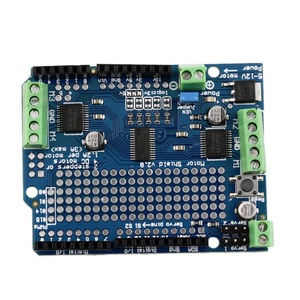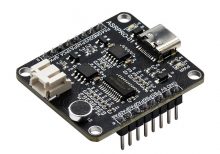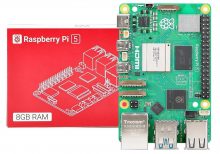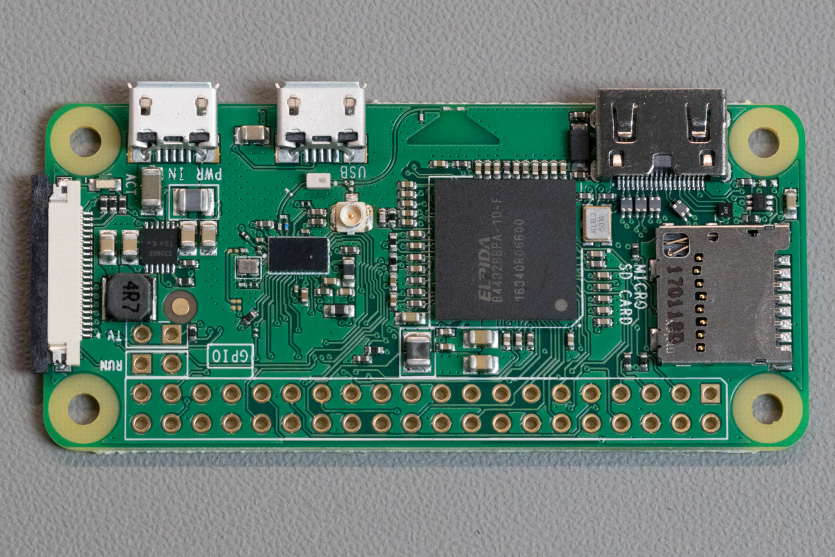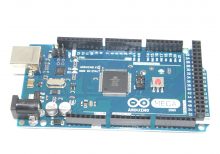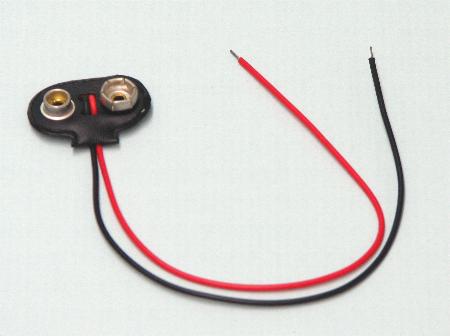|
Description |
The Arduino Motor Shield V2 is an add-on board designed to expand the capabilities of Arduino boards for controlling motors. It allows users to drive DC motors, stepper motors, and servo motors, making it ideal for robotics and automation projects. The shield features high-current motor drivers and integrates seamlessly with Arduino boards for easy setup and control.
Key Features:
- Drives up to 4 DC motors or 2 stepper motors
- Supports control of up to 2 servo motors
- Built-in thermal and overcurrent protection
- Stackable design for combining with other Arduino shields
- Easily configurable via Arduino libraries
- On-board power supply for motor power
Technical Specifications:
- Motor Channels: 4 DC motors or 2 stepper motors
- Servo Channels: 2
- Motor Driver: L298P (or similar high-current H-bridge driver)
- Motor Supply Voltage: 5V to 12V (depends on motor specifications)
- Motor Current Capacity: Up to 1.2A per channel continuous
- Peak Current: Up to 2A per channel
- Control Interface: Arduino compatible (uses Arduino’s Motor Shield library)
- Power Supply: External power supply required for motors; Arduino board power is used for control logic
- Dimensions: Approximately 68mm x 53mm (length x width)
- Mounting: Standard Arduino shield form factor, stackable
Applications:
- Robotics: Controls motors in robotic systems for movement and manipulation.
- Automation: Used in automated systems requiring precise motor control.
- DIY Projects: Enhances Arduino projects involving motorized components.
- Educational Projects: Ideal for learning about motor control and electronics.
Usage:
- Attach the Motor Shield V2 to an Arduino board by aligning the pins and pressing down gently.
- Connect DC motors, stepper motors, or servo motors to the designated terminals on the shield.
- Connect an appropriate external power supply to the shield’s motor power input.
- Use the Arduino Motor Shield library to program and control the motors via your Arduino IDE.
Caution:
- Ensure that the power supply voltage and current ratings are within the shield’s specifications to avoid damage.
- Verify all connections before powering the system to prevent short circuits.
- Use proper cooling if operating motors at high currents to avoid overheating.
Datasheet:
For detailed technical specifications, refer to the Arduino Motor Shield V2 Datasheet.
|
|
The Raspberry Pi 5 (8GB RAM) is the latest iteration in the Raspberry Pi series, featuring significant performance improvements and expanded memory to handle more demanding applications. With a powerful quad-core processor, enhanced GPU, and versatile connectivity options, this compact single-board computer is ideal for a wide range of projects and applications.
Key Features:
- 8GB RAM: Ample memory for complex tasks and multitasking
- Quad-Core Processor: Enhanced processing power for improved performance
- Enhanced GPU: Supports 4K video output and better graphics performance
- Multiple Connectivity Options: USB 3.0 ports, Gigabit Ethernet, Bluetooth 5.0, and Wi-Fi
- Expandable Storage: MicroSD card slot and USB boot capability
- GPIO Pins: 40-pin GPIO header for hardware projects
Technical Specifications:
- Processor: Quad-core ARM Cortex-A72, 1.8GHz
- Memory: 8GB LPDDR4 RAM
- Graphics: Broadcom VideoCore VI, supports dual 4K displays
- Storage: MicroSD card slot, USB boot support
- Connectivity:
- 2 x USB 3.0 ports
- 2 x USB 2.0 ports
- Gigabit Ethernet
- Dual-band 2.4/5.0 GHz IEEE 802.11ac wireless
- Bluetooth 5.0
- Video Output: 2 x micro HDMI ports (supports up to 4K resolution)
- Audio Output: 3.5mm audio jack, HDMI
- Power Supply: 5V/3A USB-C power input
- GPIO: 40-pin GPIO header
- Operating System: Compatible with Raspberry Pi OS and various Linux distributions
Applications:
- Home automation
- Media centers and streaming devices
- IoT projects
- Educational tools for learning programming and electronics
- Personal computing and office tasks
- Robotics and AI projects
Usage:
- Insert a pre-loaded microSD card with the operating system into the microSD card slot.
- Connect peripherals such as a keyboard, mouse, and monitor.
- Plug in the power supply to the USB-C power input.
- Set up and configure your Raspberry Pi 5 as needed.
Caution:
- Use a high-quality power supply to ensure stable operation.
- Handle the board with care to avoid static damage to components.
Datasheet:
For more detailed technical information, refer to the Raspberry Pi 5 (8GB RAM) Datasheet.
|
The Raspberry Pi 3 Model A+ is a compact and cost-effective variant of the Raspberry Pi 3 series, designed to deliver high performance in a smaller form factor. It retains many of the features of the Raspberry Pi 3 Model B+ but in a more compact size, making it ideal for projects where space and cost are critical considerations. With its quad-core processor and integrated wireless connectivity, the Raspberry Pi 3 Model A+ is perfect for a wide range of applications, from IoT projects to DIY electronics and educational purposes.
Key Features:
- Quad-Core Processor: 1.4 GHz 64-bit quad-core ARM Cortex-A53 CPU for powerful performance.
- Wireless Connectivity: Integrated 2.4GHz and 5GHz IEEE 802.11.b/g/n/ac Wi-Fi and Bluetooth 4.2/BLE.
- Memory: 512MB LPDDR2 SDRAM.
- Compact Form Factor: Smaller size compared to the Raspberry Pi 3 Model B+, making it ideal for space-constrained projects.
- USB Port: One USB 2.0 port for connecting peripherals.
- HDMI Output: Full-size HDMI port for high-definition video output.
- Audio: 3.5mm audio jack and HDMI audio output.
- GPIO Pins: 40-pin GPIO header, compatible with Raspberry Pi HATs and add-on boards.
- Camera and Display Interfaces: CSI camera port for connecting a Raspberry Pi camera and DSI display port for connecting a Raspberry Pi touchscreen display.
- Micro SD Slot: For storage and operating system, located on the bottom of the board.
Technical Specifications:
- Processor: Broadcom BCM2837B0, Cortex-A53 (ARMv8) 64-bit SoC @ 1.4 GHz
- Memory: 512MB LPDDR2 SDRAM
- Wireless: 2.4GHz and 5GHz IEEE 802.11.b/g/n/ac Wi-Fi, Bluetooth 4.2, BLE
- USB Ports: 1 x USB 2.0
- Video & Audio Output: HDMI, composite video (via 3.5mm jack), and stereo audio
- GPIO: 40-pin header with 28 GPIO pins, 3.3V, 5V, ground, and various communication protocols (UART, I2C, SPI)
- Power: 5V/2.5A DC via micro-USB connector
- Dimensions: 65mm x 56.5mm x 15mm
- Weight: 29g
Applications:
- IoT Projects: Suitable for various Internet of Things applications.
- DIY Electronics: Ideal for hobbyist and maker projects.
- Educational Use: Perfect for learning programming, electronics, and computer science.
- Media Centers: Can be used as a media center with software like Kodi.
- Embedded Projects: Suitable for embedding into other projects due to its compact size.
- Home Automation: Useful for creating smart home applications.
Datasheet:
For detailed technical specifications, refer to the Raspberry Pi 3 Model A+ Datasheet.
|
The DF Mini MP3 Player is a compact and cost-effective MP3 module that can be directly connected to a speaker. It can be used as a standalone module with battery, speaker, and push buttons, or in combination with an Arduino or other controller with RX/TX capabilities. It is widely used in applications like voice announcements, sound effects, and audio playback in various projects.
Key Features:
- Compact Size: Small form factor for easy integration
- Storage: Supports microSD cards up to 32GB
- File Format: MP3, WAV, and WMA file formats
- Built-in Amplifier: 3W amplifier for direct speaker connection
- Control Interface: Serial (UART), AD (Analog), or GPIO (General Purpose Input/Output)
- Power Supply: 3.2V to 5.0V DC
Technical Specifications:
- Operating Voltage: 3.2V to 5.0V DC
- Storage Medium: MicroSD card (up to 32GB)
- Audio Formats: MP3, WAV, WMA
- Amplifier: 3W built-in amplifier
- Control Interface:
- Serial (UART): For communication with microcontrollers
- AD (Analog): For controlling playback with potentiometers
- GPIO: For simple control using buttons or switches
- Output: Speaker (direct connection), headphone jack (if available)
- Dimensions: Compact and suitable for integration into various projects
Applications:
- Voice Announcements: Ideal for applications requiring voice prompts or messages.
- Sound Effects: Used in interactive displays, exhibits, and installations.
- Audio Playback: Suitable for DIY projects, toys, and educational tools.
- Embedded Systems: Integrated into products requiring audio feedback or instructions.
- Prototyping: Useful in developing and testing audio-based applications.
Datasheet:
For detailed technical information, refer to the DF Mini MP3 Player datasheet.
|
The Raspberry Pi Zero W is a compact, low-cost single-board computer that includes built-in Wi-Fi and Bluetooth connectivity. It is designed for a wide range of applications, including embedded projects, IoT devices, and educational tools. The Raspberry Pi Zero W is highly valued for its small form factor and powerful performance relative to its size.
Key Features:
- Processor: 1GHz single-core ARM11 CPU
- Memory: 512MB RAM
- Wireless Connectivity: 802.11 b/g/n Wi-Fi, Bluetooth 4.1, Bluetooth Low Energy (BLE)
- Ports:
- Mini HDMI port for video output
- Micro USB OTG port for data and power
- Micro USB power port
- CSI camera connector
- GPIO: 40-pin GPIO header (unpopulated)
- Storage: MicroSD card slot for operating system and data storage
Technical Specifications:
- Processor: Broadcom BCM2835, 1GHz single-core ARM11
- Memory: 512MB LPDDR2 SDRAM
- Wireless Connectivity:
- 802.11 b/g/n Wi-Fi
- Bluetooth 4.1
- Bluetooth Low Energy (BLE)
- Video Output: Mini HDMI with 1080p60 support
- Audio Output: Via HDMI or I2S
- USB Ports:
- 1 x Micro USB OTG port
- 1 x Micro USB power port
- Camera Interface: CSI camera connector
- GPIO: 40-pin header with various functions (unpopulated)
- Storage: MicroSD card slot
- Dimensions: 65mm x 30mm x 5mm
- Power: 5V, 1.2A via Micro USB
Applications:
- Embedded Projects: Ideal for embedding into custom electronic devices due to its small size and wireless capabilities.
- IoT Devices: Suitable for Internet of Things (IoT) applications needing Wi-Fi and Bluetooth connectivity.
- Education: Used in educational environments to teach programming, electronics, and computer science.
- DIY Projects: Perfect for hobbyists creating custom gadgets, robots, and other interactive installations.
- Media Centers: Can be used to create low-cost media centers or streaming devices.
Datasheet:
For detailed technical information, refer to the official Raspberry Pi Zero W datasheet and documentation.
|
The Arduino Mega 2560 is a popular microcontroller board based on the ATmega2560 chip, offering a substantial increase in input/output (I/O) pins, memory, and functionality compared to other Arduino boards. It is designed for projects requiring a large number of I/O pins or more complex operations, making it suitable for advanced hobbyist and professional applications.
Key Features:
- ATmega2560 Microcontroller
- 256KB Flash memory for storing code
- 8KB SRAM for data storage
- 4KB EEPROM for non-volatile data storage
- 54 Digital I/O pins (15 with PWM output)
- 16 Analog input pins
- 4 Hardware serial ports (UARTs)
- 16 MHz Clock speed
- USB connection for programming and power
- Power jack for external power supply
- Built-in LED on pin 13
Technical Specifications:
- Microcontroller: ATmega2560
- Operating Voltage: 5V
- Input Voltage (recommended): 7-12V
- Input Voltage (limit): 6-20V
- Digital I/O Pins: 54 (15 with PWM)
- Analog Input Pins: 16
- Flash Memory: 256 KB (of which 8 KB used by bootloader)
- SRAM: 8 KB
- EEPROM: 4 KB
- Clock Speed: 16 MHz
- Dimensions: 101.6 mm x 53.3 mm (4 in x 2.1 in)
- Weight: Approximately 37 g (1.3 oz)
Applications:
- Robotics: Control motors, sensors, and other peripherals for robotic systems
- Home Automation: Interface with various sensors and actuators for smart home projects
- Data Logging: Collect and store data from multiple sensors for analysis
- Prototyping: Develop and test complex electronic circuits and systems
- Educational Projects: Use in educational environments to teach microcontroller programming and electronics
Usage:
- Connect the Arduino Mega 2560 to your computer via USB for programming.
- Use the Arduino IDE to write and upload code to the board.
- Interface with external hardware using the I/O pins for various applications.
- Power the board using either the USB connection or an external power supply.
Caution:
- Ensure the input voltage does not exceed the recommended range to avoid damaging the board.
- Verify connections to avoid incorrect wiring or short circuits.
- Handle with care to prevent damage to the board or its components.
Datasheet:
For detailed technical specifications, refer to the Arduino Mega 2560 Datasheet.
|
The 20W Hot Melt Glue Gun is a versatile adhesive tool designed for use with hot glue sticks. It heats and melts glue sticks, allowing for quick and easy bonding of various materials such as wood, plastic, fabric, and metal. Ideal for crafting, DIY projects, and repairs, this glue gun provides precise control and strong adhesive bonds.
Key Features:
- 20W power rating for efficient heating and melting of glue
- Ergonomic design for comfortable handling
- Adjustable stand for stability during use
- Quick heating time for faster work
- Compatible with standard hot glue sticks (usually 7mm or 11mm diameter)
- On/Off switch for convenient operation
Technical Specifications:
- Power Rating: 20W
- Voltage: Typically 220V AC (varies by region)
- Heat Time: Approximately 3-5 minutes to reach operating temperature
- Temperature Range: Approximately 160°C to 180°C (320°F to 356°F)
- Glue Stick Diameter: Compatible with 7mm or 11mm diameter glue sticks
- Weight: Typically around 150-200 grams
- Material: Plastic body with metal nozzle
Applications:
- Crafting and DIY projects
- Repairs of household items and electronics
- Assembly of wooden, plastic, and metal parts
- Artistic and creative projects
- General-purpose adhesive applications
Usage:
- Insert the glue stick into the rear of the glue gun.
- Plug in the glue gun and turn it on using the switch.
- Wait for 3-5 minutes for the glue gun to heat up and melt the glue.
- Squeeze the trigger to apply the molten glue to the surfaces you wish to bond.
- Hold the surfaces together until the glue sets (usually within 10-20 seconds).
- Turn off the glue gun and unplug it when not in use.
Caution:
- Handle the glue gun carefully to avoid burns from the hot glue and the heated nozzle.
- Ensure the glue gun is placed on a heat-resistant surface or its stand while in use.
- Keep out of reach of children and follow the manufacturer’s safety instructions.
Datasheet:
For detailed technical specifications, refer to the 20W Hot Melt Glue Gun Datasheet.
|
The 9V Battery Connector is a convenient and reliable accessory used to connect 9V batteries to electronic circuits and devices. It features a pair of snap connectors that securely attach to the terminals of a 9V battery, providing an easy way to power various projects and components.
Key Features:
- Easy and secure connection to 9V batteries
- Color-coded wires for correct polarity
- Flexible and durable leads for reliable connections
- Compatible with various electronic projects and devices
- Lightweight and compact design
Technical Specifications:
- Connector Type: Snap-on for 9V battery
- Wire Length: Typically around 15cm (varies by manufacturer)
- Wire Gauge: 24 AWG (varies by manufacturer)
- Polarity: Red wire for positive (+), black wire for negative (-)
- Material: Plastic housing with metal contacts
- Rated Voltage: 9V
- Current Capacity: Up to 1A
Applications:
- Powering small electronic projects
- Battery-powered devices
- Portable electronics
- Prototyping and breadboarding
- DIY and hobby projects
Usage:
- Connection:
- Snap the connector onto the terminals of a 9V battery, ensuring correct polarity (red wire to positive, black wire to negative).
- Wiring:
- Connect the leads to your circuit or device, observing proper polarity.
- Use solder, connectors, or a breadboard to make secure connections.
- Powering Devices:
- Use the 9V battery and connector to power your electronic projects, ensuring the voltage and current requirements are compatible.
Caution:
- Ensure correct polarity to avoid damaging the battery or connected device.
- Handle the connector and wires carefully to prevent short circuits.
- Avoid excessive bending or pulling on the wires to maintain reliable connections.
|
